Survive and thrive: delve into the fascinating world of bees and their ingenious strategies for outwitting predators.

How Do Bees Avoid Their Predators?
Much like a skilled boxer in the ring, a bee is equipped with an array of strategies and mechanisms to evade its numerous predators. You've probably observed bees in your garden, buzzing from flower to flower, seemingly oblivious to the threats around them.
However, these industrious insects are far from defenseless, boasting a multifaceted system of defenses that includes physical attributes and collective hive tactics. Ever wondered how they manage to survive in a world full of threats?
Well, it's time to discover the intricate ways bees protect themselves, and you may find that there's more to these humble creatures than meets the eye.
Key Takeaways
- Bees have physical defense mechanisms such as stingers, alarm pheromones, and a hard exoskeleton to protect themselves from predators.
- Bees utilize collective defense strategies, including mass attacks and balling, to ward off larger threats to the hive.
- Bee communication and warning systems, through dances and pheromones, allow bees to coordinate their responses to predators.
- Pheromones play a crucial role in bee protection by alerting the hive to danger, guiding bees back to the hive, and acting as a beacon for worker bees.
Understanding Bee Predators
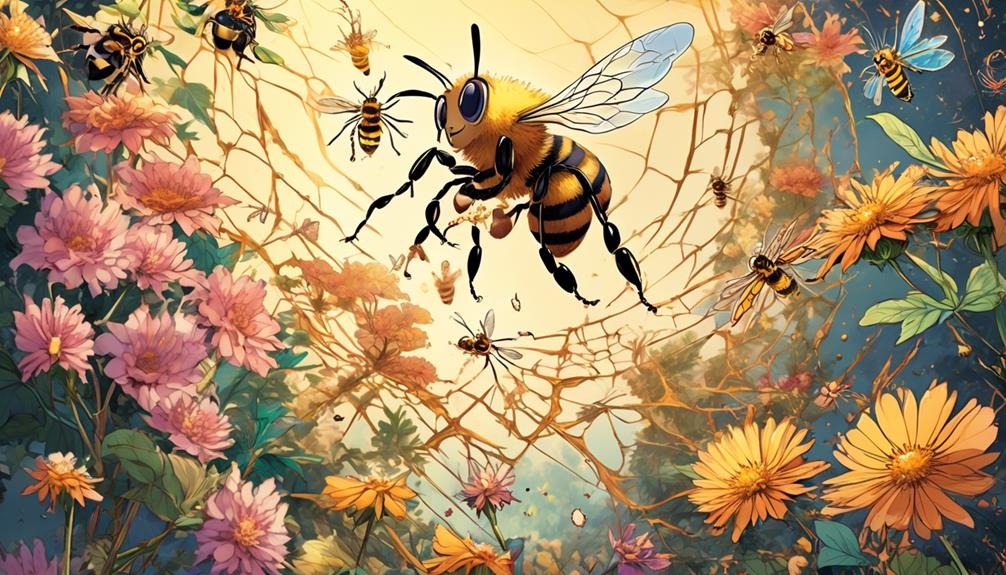
To fully appreciate the survival tactics of bees, you'll first need to understand their predators, a diverse group that ranges from insects to mammals and even birds. The biggest threats are often other insects, particularly wasps and hornets, who raid hives for honey and larvae. Spiders, too, pose a danger, snatching bees from the air with their intricate webs.
Mammalian predators, such as bears, badgers, and mice, are also attracted to the sweet lure of honey, often causing extensive damage to hives in their pursuit. Additionally, birds, such as bee-eaters, swifts, and kingbirds, are adept at catching bees mid-flight. But it's not just the animal kingdom bees have to contend with. Humans, too, pose a threat through habitat destruction and the use of harmful pesticides.
Understanding these threats helps us appreciate the myriad ways that bees have evolved to protect themselves. From the complex social structures of honeybees, which allow for coordinated defense, to the solitary carpenter bee's ability to bore into wood for protection, bees illustrate a remarkable adaptability in the face of diverse predators. Each survival tactic is a testament to the resilience and ingenuity of these vital pollinators.
Bee's Physical Defense Mechanisms
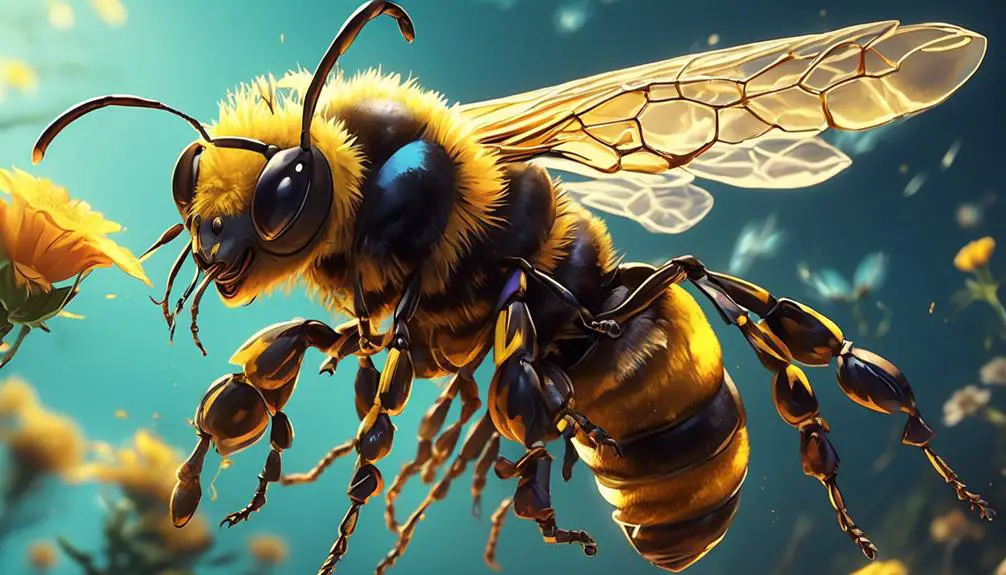
You'll find that bees employ a variety of physical defense mechanisms, ranging from their well-known stingers to less-known tactics like alarm pheromones, to protect themselves from the wide array of predators they face.
The stinger is an incredibly effective tool for bees. It's not just a needle-like appendage; it's a complex structure that delivers a venomous cocktail capable of causing intense pain and, in rare cases, severe allergic reactions in predators. The stinger's barbed design ensures that it remains lodged in the attacker, continuously pumping venom even after the bee has departed.
But stinging isn't the bees' only defense. They also use alarm pheromones, chemical signals released when a bee stings or feels threatened. These pheromones alert other bees to the danger, inciting them to attack or flee. This communal defensive behavior demonstrates the bees' remarkable cooperation and coordination.
Additionally, some bees even utilize their hard exoskeleton as a shield, resisting the bites and pecks of larger predators. They also employ evasive flight patterns and hide in their hives to avoid threats.
Understanding these physical defenses highlights the resilience and adaptability of bees in the face of danger, showing us just how hard these crucial pollinators work to survive.
The Hive's Collective Defense
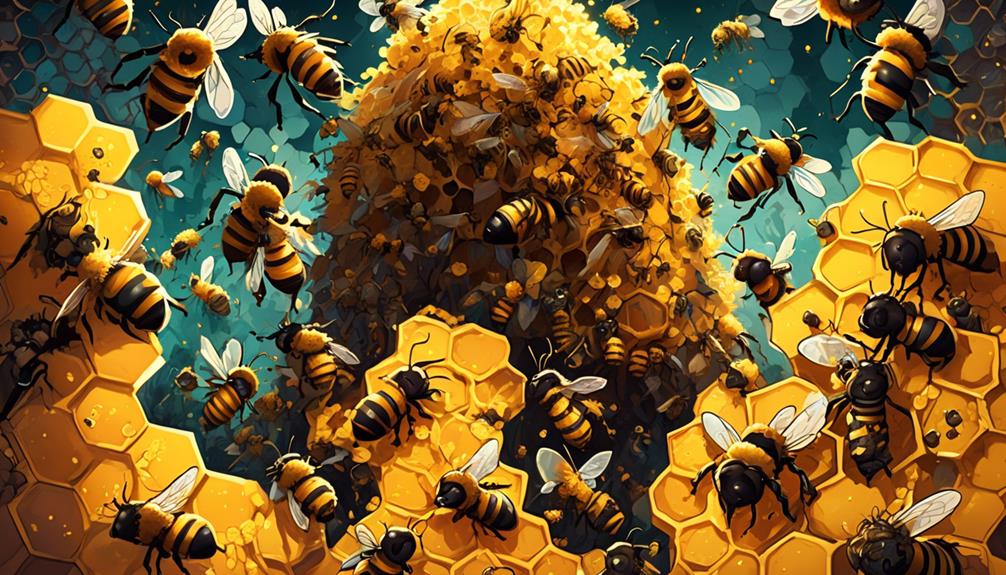
Diving deeper into the world of bee defenses, let's explore how the entire hive bands together, forming a collective fortress against potential threats. This form of defense, known as mass attack, is triggered when a threat is too large to be managed by a single bee.
Bees employ two main strategies in their collective defense: balling and stinging. When a threat like a hornet invades, hundreds of bees swarm the intruder, vibrating their muscles and generating heat in a process known as "balling". This literally cooks the invader alive. Stinging, on the other hand, is reserved for larger threats like mammals. Once a bee stings, it releases pheromones that signal others to join the attack.
Here's a table to summarize these actions:
Collective Defense Strategy | Method |
|---|---|
Balling | Swarm the intruder, vibrate muscles, generate heat |
Stinging | Sting the predator, release pheromones to attract others |
Bee Communication and Warning Systems
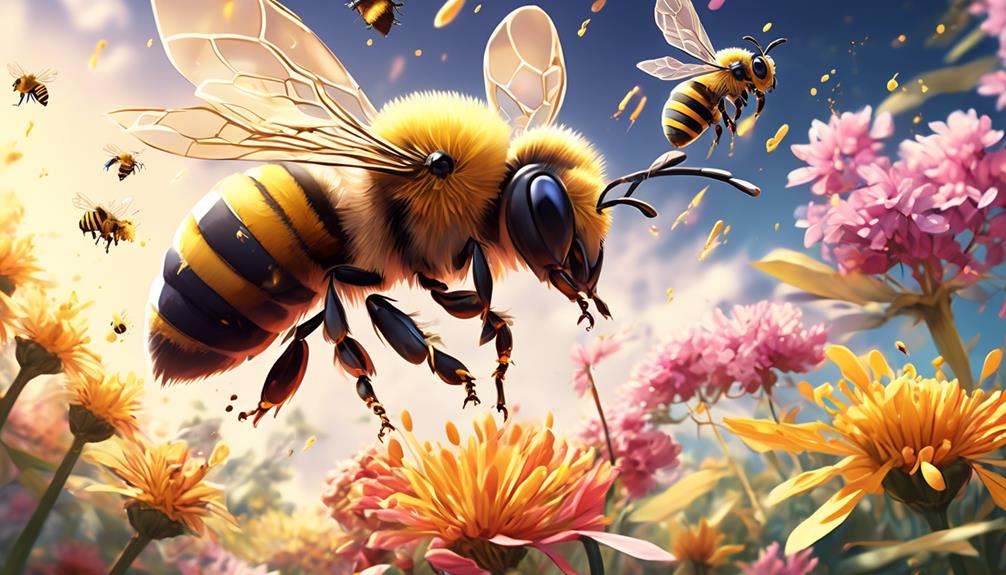
Building on the hive's collective defense strategies, it's crucial to understand the intricate communication and warning systems bees employ to alert each other about potential threats. Bees don't just react individually to a threat; they're able to communicate and coordinate their responses, acting as one cohesive unit.
Bees use a complex language of dance and pheromones to communicate. For instance, if a forager bee encounters a threat while collecting nectar, it'll perform a specific dance upon returning to the hive. This dance alerts other bees to the danger, and they'll avoid that area when venturing out for nectar.
In addition to dancing, bees emit pheromones to warn their hive mates. Alarm pheromones are released when a bee stings an intruder. This scent signals other bees to attack the same spot, reinforcing the defense.
Moreover, guard bees, strategically positioned at the hive entrance, have the responsibility to identify and stop intruders. If a predator is detected, these guards release pheromones to raise the alarm, triggering a mass defense.
Therefore, the success of bees in avoiding predators doesn't just rely on their individual abilities, but also on their collective communication and warning systems.
Role of Pheromones in Protection
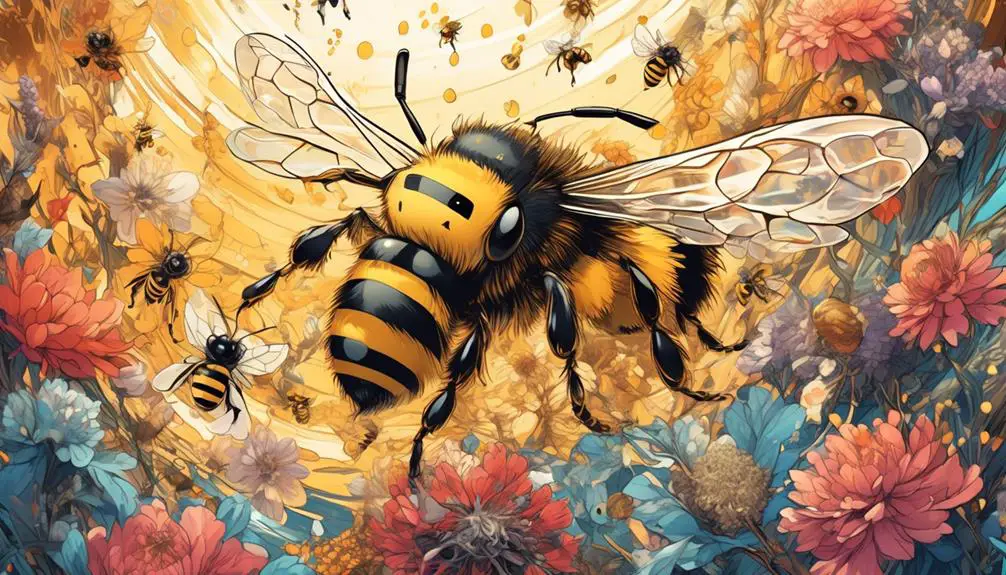
In understanding the role of pheromones in the bees' defense, it's important to delve into their unique chemical language that plays a pivotal part in their survival. Bees, like many other insects, communicate through pheromones, which are chemical signals released into the environment that trigger specific behaviors or responses in other bees.
When sensing a threat, bees release alarm pheromones. These chemicals are incredibly potent, alerting the entire hive to the presence of danger within seconds. This initiates an immediate defensive response, with bees swarming and stinging the predator. The sting itself releases more alarm pheromones, further escalating the defense.
Aside from sounding the alarm, pheromones also play a role in guiding bees back to their hive. The queen bee releases a special pheromone that acts like a beacon, ensuring that the workers can always find their way home, even when foraging far afield.
Case Studies: Bee Survival Tactics

Let's explore some fascinating examples of how bees employ ingenious survival tactics to evade their predators.
You'll find it interesting that the Japanese honeybee has developed a unique method to fend off the Asian giant hornet. When a hornet scout enters their hive, the bees surround it, forming a 'hot defensive bee ball.' They vibrate their bodies, generating heat and carbon dioxide, effectively cooking and suffocating the hornet. This is a prime example of how bees use collective defense strategies for survival.
Consider another case, the Africanized honeybee, often dubbed the 'killer bee'. Unlike their more docile counterparts, these bees are incredibly aggressive and swarm in large numbers when their hive is threatened. They've been known to chase their predators for a mile or more. This aggressive behavior is their primary survival tactic.
Lastly, look at the European honeybee. When faced with a threat, they use their stingers in a last-ditch effort to ward off predators. Although they die after stinging, this self-sacrifice helps protect the colony.
These case studies are a testament to the remarkable survival tactics bees have evolved over millennia.
Frequently Asked Questions
How Do Bees Contribute to the Ecosystem Aside From Their Defense Mechanisms?
You're probably aware that bees play a crucial role in pollination. They flit from flower to flower, picking up pollen on their bodies, and then depositing it on other plants. This helps plants reproduce, promoting biodiversity.
Bees also produce honey, a natural sweetener. They're vital for food crops and wild plants alike. Without bees, our ecosystem would be significantly less diverse and our food supply would be in jeopardy.
How Do Human Activities Impact the Survival of Bees?
Your actions greatly impact bees' survival. Pesticide use and habitat destruction are two major factors that harm bees. Pesticides can poison bees directly or disrupt their navigation. On the other hand, destroying natural habitats for development reduces bees' food sources, making their survival even harder. It is crucial to understand the implications of your actions and make eco-friendly choices. By doing so, we can ensure that these essential pollinators continue to contribute to our ecosystem.
What Is the Lifespan of a Typical Bee and How Does Predator Avoidance Influence It?
A typical bee's lifespan can range from a few weeks to several months, depending on the species.
Your bee's lifespan could be affected by predator avoidance, where it uses its sharp senses and quick reflexes to dodge danger.
While it's tough to precisely measure how evasion tactics lengthen a bee's life, it's clear that a bee's ability to avoid predators contributes significantly to its survival.
How Does Climate Change Affect Bees' Ability to Avoid Predators?
Climate change can disrupt bees' predator avoidance tactics. Unpredictable weather patterns can alter their flight paths, making it harder for them to evade threats. Additionally, warmer temperatures can lead to increased predator activity, putting bees at higher risk.
You'd also find that climate change may disrupt the timing of bees' lifecycle stages, potentially exposing them when they're most vulnerable. In essence, climate change presents significant challenges to bees' survival, including their ability to avoid predators.
What Other Insects Have Similar Predator Avoidance Mechanisms as Bees?
Like bees, many other insects have developed clever mechanisms to dodge predators. Butterflies, for instance, use their bright colors to signal danger, while stick insects blend into their surroundings. Moths use a mix of both: some species camouflage, others mimic dangerous insects.
You'll find that wasps, much like bees, use their stingers as a defense. So, despite their differences, these insects share a common goal: survival through predator avoidance.
Conclusion
So, you see, bees aren't just industrious pollinators; they're also masters of survival. Through physical defenses, collective hive protection, advanced communication, and pheromones, they've developed intricate strategies to ward off predators.
Fascinating case studies further illuminate their survival tactics. It's clear that bees aren't only essential for our ecosystem, but also remarkable examples of nature's resilience.
Let's appreciate and protect these small but mighty creatures.


